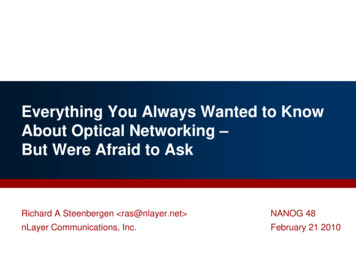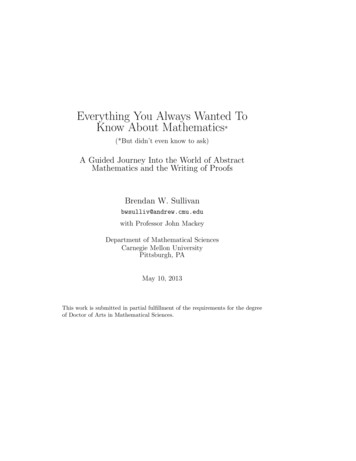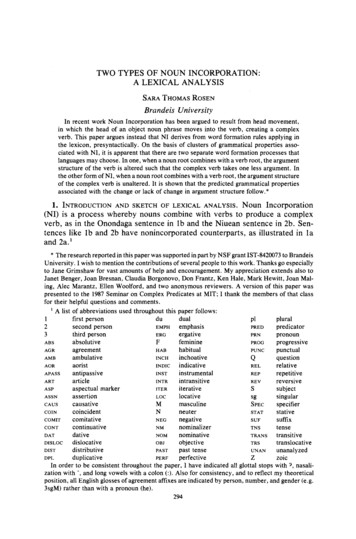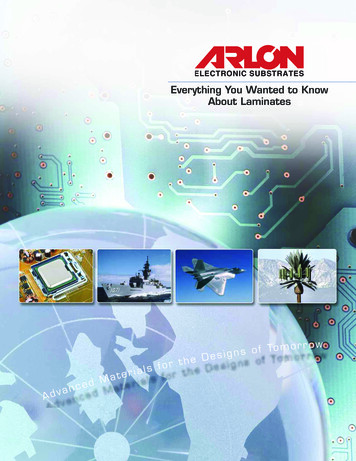
Transcription
Everything You Always Wanted to KnowAbout Optical Networking –But Were Afraid to AskRichard A Steenbergen ras@nlayer.net NANOG 48nLayer Communications, Inc.February 21 20101
Purpose of This Tutorial Why talk about optical networking? The Internet as an industry is largely based around fiber. Yet many router jockeys don’t get enough exposure to it. This leads to a wide variety of confusion, misconceptions,and errors when working with fiber optic networks. Will this presentation make me an optical engineer? Probably not. The purpose of this tutorial is to touch on a little of everytopic, from the mundane to the unusual. But it helps to have a basic understanding of these topics,even if you aren’t designing fiber networks.2
The Basics3
How Does Fiber Work? Fiber is essentially a waveguide for light. Using a principal known as “Total Internal Reflection” Fiber cables are internally composed of two layers. Known as the “core” and the “cladding”. The core layer is surrounded by the cladding layer. And the cladding layer has a higher index of refraction than the core. When light tries to pass from a lower to a higher index ofrefraction, at the correct angle, it is reflected back instead. This causes light to be continuously reflected back into thecore, allowing the light to travel to the other end of the fiber.4
Diagram Showing Internal Reflection5
Gratuitous Example Image From Wikipedia6
The Inside of a Single-Mode Fiber CableJacket(400 μm)Buffer(250 μm)Cladding(125 μm)Core(8.5μm)7
What We Transmit Over Fiber Digital signals are encoded in analog pulses of light. Today, primarily via a method known a Non-Return toZero (NRZ) modulation. Most fibers operate in duplex (pairs) One fiber is used to transmit, the other is used to receive. But it is possible to send both signals over a single strand.8
Basic Fiber Types9
Fiber Types Network fiber can be classified into two main types Single Mode Fiber (SMF) Multi-Mode Fiber (MMF) The difference is primarily in the size of the core Multi-mode fiber has a wide core, allowing multiplemodes of light to propagate. Single-mode fiber has a narrow core, allowing only asingle mode of light to propagate.10
Multi-Mode Fiber Multi-Mode Fiber Has two common core sizes (62.5μm OM1, or 50μm OM2) Specifically designed for use with “cheaper” optics The wide core lets you use incoherent LED light sources. Or cheaper, less precisely aimed lasers. Typically operates at 850nm or 1310nm. But this comes at the expense of long-distance reach Modal distortion significantly limits the maximum distance. Typically limited to between “tens to hundreds of meters”. Recently augmented with “laser optimized” (OM3) MMF Uses aqua colored cables, rather than the traditional orange. Designed to achieve 10Gbps at 300 meters with VCSEL lasers.11
Single-Mode Fiber Single-Mode Fiber Has a core size of between 8-10 microns (μm) SMF supports distances up to several thousand kilometers With appropriate amplification and dispersion compensation. But requires more expensive, coherent laser light sources. Typically in the 1270nm – 1625nm range. “Classic” Single-Mode Fiber is frequently called SMF-28 But a wide variety of specialty fibers have been developed as well. Low Water Peak Fiber (LWPF), Dispersion Shifted Fiber (DSF),Non-Zero Dispersion Shifted Fiber (NZDSF), etc.12
Modal Distortion in Multimode Fiber13
Mode Conditioning Cables What happens to a “narrow” laser inside “wide” MMF? It gets bounced around, causing modal distortions. This can be improved with a Mode Conditioning Cable A manufactured splice between the SMF and MMF cables,precisely setting the angle of the light sent into the MMF. By controlling the angle, modal distortions can be reduced,allowing greater distances to be achieved over MMF. For example, a 1GE LX over MMF would go from 300M to 550M.14
Different Optical Transmitter Types15
What Happens When You ?Transmit Optic TypeMultimode FiberSingle-mode FiberLED Source (traditional850nm/SX Gigabitoptics, etc)Limited by modaldistortion, achieves afew hundred metersdepending on the exactsignal and type of fiber.Limited by attenuation,diffuse signal doesn’t fitinto the narrow fibercore, you may achieve afew meters at best.Laser Source (LX/LR,ER, ZX/ZR, etc)Limited by modaldistortion, but shouldperform as well or betterthan an LED source. Notrecommended, but it will“work” with a dB hit if youpass a long-reach signalthrough a short stretch ofMMF (patch cable, etc).Achieves maximumdistance determined bysignal attenuation andother criteria (10km,40km, 80km, etc).16
Fiber-Optic Pluggable Transceivers Previously discussed at great length NANOG 29, Oct 2003, 1G Pluggable Transceivers s/wodelet.pdf NANOG 42, Feb 2008, 10G Pluggable Transceivers s/pluggables.pdf Some updates from 2 years later: SFP is now shipping in large quantities, at pretty reasonable prices too.10GBASE-SR, LR, LRM optics are now available from the router vendors.Longer reach optics (ER, ZR) are in the pipeline too, ER is shipping soon.Some no-name vendors are even advertising 18-channel CWDM 40km.No DWDM optics on the horizon yet, but it’s only a matter of time.SFP is the “format of choice” for new, high density, enterprise-grade boxes.Still not a complete replacement for XFP, but attractive on 32/48-port blades.17
Optical Networking Terms and Concepts18
Optical Power What is optical power? Quite simply, the brightness (or “intensity”) of light. As light travels through fiber, some energy is lost. Either absorbed by the glass particles and converted to heat; Or scattered by microscopic imperfections in the fiber. This loss of intensity is called “attenuation”. We typically measure optical power in “Decibels” A decibel (dB, 1/10th of a Bel) is a logarithmic-scale unitexpressing the relationship between two values. The decibel is a “dimensionless-unit”, meaning it doesnot express an actual physical measurement on its own.19
Optical Power and the Decibel A decibel itself is simply a ratio between values 0 dB is no change, 3 dB is double, -3 dB is half, etc. To express an absolute value (i.e. an actual light level),it must be compared to a known reference value. In optical networking, this is typically the dBm. That is, a decibel relative to 1 milliwatt (mW) of power.0 dBm is 1 mW, 3 dBm is 2 mW, -3 dBm is 0.5mW, etc.So what does this make 0mW? Negative Infinity dBm.Confusion between dB and dBm is one of the mostcommon mistakes when working with optical networks!20
Optical Power and the Decibel So why do we measure light with the Decibel? Light, like sound, follows the inverse square law. The signal is inversely proportional to the distance squared. A signal travels distance X and loses half of its intensity. The signal travels another distance X and loses another half. After 2X only 25% remains, after 3X only 12.5% remains. Using a logarithmic scale simplifies the calculations. A 3dB change is approximately half/double the original signal.In the example above, there is a 3dB loss per distance X.At distance 2X there is 6dB of loss, at distance 3X it is 9dB.This allows us to use addition when measuring gains/losses.21
Decibel to Power Conversion Table(loss)22
Dispersion Dispersion simply means “to spread out”. In optical networking, this results in signal degradation. There are two main types of dispersion to deal with Chromatic Dispersion Different frequencies of light propagate through a non-vacuum atslightly different speeds. This is how optical prisms work. But if one part of an optical signal travels faster than the otherpart, the signal will eventually “smear out” over long distances. Polarization Mode Dispersion Caused by imperfection in shape of the fiber (not perfectly round). One polarization of light propagates faster than the other. Older fiber is particularly affected, may get worse with age.23
The Effects of Dispersion As the signal is dispersed, it is no longerdistinguishable as individual pulses at the receiver.24
Fiber Optic Transmission Bands There are several frequency “windows” available 850nm – The First Window Highest attenuation, only used for short reach applications today. 1310nm – The Second Window (O-band) The point of zero dispersion on classic SMF, but high attenuation. Primarily used for medium-reach applications (up to 10km) today. 1550nm – Third Window (C-band) Stands for “conventional band”, covers 1525nm – 1565nm. Has the lowest rate of attenuation over SMF. Used for almost all long-reach and DWDM applications today. Forth Window (L-band) Stands for “long band”, covers 1570nm – 1610nm.25
Fiber Optic Transmission Bands26
Forward Error Correction Forward Error Correction Adds extra/redundant information to a transmission sothat a receiver can “recover” from small errors. Think of it like RAID5 for your wavelengths. Even if youlose some data, you can still recover it computationally. FEC works by extending the receiver sensitivity to levelswhich would normally have too many bit errors to use. Using clever math, padding a 10.325Gbps signal to11Gbps (7% overhead) can extend a 80km wavelengthto 120km or beyond, at the same or better bit error rate. Typically implemented as a digital “wrapper” (G.709) onan existing signal.27
The Benefits of Forward Error Correction28
OTN Digital Wrapper Technology (G.709) OTN stands for Optical Transport Network A set of standards which allow interoperability and thegeneric transport of any protocol across an optical network. Implemented as a “wrapper” around another protocol. Why is this needed? So the optical network can be completely transparent. Also, some protocols don’t have the same level of troubleshootingcapabilities as other protocols. For example, Ethernet is notas good as SONET, becauseEthernet wasn’t originallydesigned for the WAN. An OTN wrapper allows theoptical network operator to troubleshoot with OTN instead.29
Wave Division Multiplexing30
Wave Division Multiplexing (WDM) What is Wave Division Multiplexing (WDM)? We know that light comes in many different colors. These different colors can be combined on the same fiber. The goal is to have signals not interfere with each other. “Ships in the night” approach.31
Different Types of WDM There are several different types of WDM The most common terms are Dense and Coarse. Essentially they both do the same thing in the same way. The only difference is the channel spacing. And the range of the optical spectrum they typically cover.32
Coarse Wavelength-Division Multiplexing CWDM is loosely used to mean anything not DWDM The most “popular” meaning is 8 channels with 20nm spacing. Centered on 1470 / 1490 / 1510 / 1530 / 1550 / 1570 / 1590 / 1610 With Low Water Peak fiber, another 10 channels are possible Centered on 1270/1290/1310/1330/1350/1370/1390/1410/1430/1450. Can also be used to refer to a simple 1310/1550nm mux.33
Dense Wavelength-Division Multiplexing What exactly is Dense WDM (DWDM)? A much more tightly packed WDM system.Typically used for commercial long-haul systems.And typically based in the C-band.Specific channel sizes are standardized in an “ITU Grid”.Within C-band, these channel spacings are common: 200GHz – 1.6nm spacing, 20 channels possible100GHz – 0.8nm spacing, 40 channels possible50GHz – 0.4nm spacing, 80 channels possible25GHz – 0.2nm spacing, 160 channels possible 200GHz is “2000-era old tech”, 100GHz is common onpluggables or cheaper systems, 50/25GHz are “modern”.34
What Are The Advantages? CWDM Cheaper, less precise lasers can be used. The actual signal in a CWDM system isn’t really any wider. But the wide channel allows for large temperature variations. Cheaper, uncooled lasers, can more easily stay within the window. DWDM Far more channels are possible within the same fiber. 160 channels (at 25GHz) in 32nm of spectrum, vs. 8ch in 160nm. Stays completely within the C-band Where attenuation and dispersion are far lower that other bands. Where Erbium Doped Amplifiers (EDFAs) work. And where dispersion compensation can be applied.35
CWDM vs. DWDM Relative Channel SizesPeak – 13nm wide20nm wide CWDM channel36
Other Uses of WDM WDM is also used in other channel combinations 10GBASE-LX4 optics, 10GbE over 4x3.2G WDM lanes Uses non-standard 1275 / 1300 / 1325 / 1350nm channels. Used to achieve longer distances over older grade MMF. 40GE and 100GE will likely offer similar integrated WDM optics. 1310/1550 muxes Simple combination of two popular windows onto a single strand. 1GBASE-BX optics for use on single-strand fibers 1310 / 1490nm mux integrated into a pluggable transceiver.37
WDM Networking Components38
WDM Mux/Demux The Mux/Demux Short for “multiplexer”, sometimes called a “filter” or “prism”. The term “filter” is how it actually works, by filtering specific colors. But most people understand a “prism” splitting light into spectrums. A simple device which combines or splits multiple colors oflight into a single fiber (called the “common” fiber). Muxes are entirely passive devices, requiring no power. A complete system requires a mux demux for TX and RX. Most modern devices function the same in both directions,as a mux or demux, so the actual device is the same. Many vendors combine the mux demux into a singleunit for simplicity, but it is really 2 distinct components.39
How a Mux Works Muxes are actually optical bandpass filters Typically based on Bragg Grating or Dichroic filters. Some frequencies are reflected, the rest are passed through. The channels actually overlap slightly, but have enoughisolation to prevent cross-talk interference.Bragg Grating Effects40
The Optical Add/Drop Multiplexer (OADM) The Optical Add/Drop Multiplexer (OADM) Selectively Adds and Drops certain WDM channels,while passing other channels through without disruption. Where a mux is used at the end-point of a WDM networkto split all of the component wavelengths, an OADM isused at a mid-point, often in a ring. With a well-constructed OADM ring,any node can reach any other nodein the ring, potentially reusing thesame wavelength multiple timesacross different portions of the ring.112233445511335541
The ROADM A somewhat recent addition to optical networking. The “Reconfigurable Optical Add/Drop Multiplexer”. Essentially a “tunable OADM”, usually in software. Allows you to control which channels are dropped andwhich are passed through, increasing channel flexibility. Some ROADMs are multi-degree Instead of only being able to “pass”or “drop”, there are more than 2directions of “pass” to choose from. This allows you to build complex startopologies at a purely optical level.42
Optical Amplifiers Optical amplifiers increase the intensity of a signal There are different types, for different spectrums of light. The most common is the Erbium Doped Fiber Amplifier. Another method is Raman Amplification, typically for ultra long-haul. In an EDFA, a piece of fiber is “doped” with Erbium ions. Additional laser power at980nm and/or 1480nm ispumped in via a coupler. The interaction betweenthe Erbium and the pumplaser causes the emissionof light in the C-band spectrum, amplifying the signal.43
Optical Switches Optical Switches Let you direct light between ports,without doing O-E-O conversion. Built with an array of tiny mirrors,which can be moved electrically. Allows you to connect two fiberstogether optically in software. Becoming popular in optical crossconnect and fiber protection roles. Also used inside of complex multidegree ROADMs, called a WSS(wavelength selectable switch).44
Circulator A component typically not seen by the end user But used to implement various other common components. Such as muxes, OADMs, and dispersion compensators. A circulator has 3 fiber ports. Light coming in port 1 goes out port 2. Light coming in port 2 goes out port 3.45
Splitters and Optical Taps Optical Splitters Do exactly what they sound like they do, split a signal. Common examples are: A 50/50 Splitter Often used for simple “optical protection”. Split your signal in half and send down two different fiber paths. Use an optical switch with power monitoring capabilities on thereceiver, have it automatically pick from the strongest signal. If the signal on one fiber drops, it switches to the other fiber. A 99/1 Splitter Often used for “Optical Performance Monitoring”. Tap 1% of the signal and run it to a spectrum analyzer.46
Types of Single Mode Optical Fiber47
Types of Single-Mode Fiber We’ve already discussed how single-mode fiber isused for essentially all long-reach fiber applications. But there are also several different types of SMF. The most common types are: “Standard” SMF (ITU-T G.652) A.K.A. SMF-28Low Water Peak Fiber (ITU-T G.652.C/D)Dispersion Shifted Fiber (ITU-T G.653)Low-Loss Fiber (ITU-T G.654)Non-Zero Dispersion Shifted Fiber (ITU-T G.655)Bend Insensitive Fiber (ITU-T G.657)48
“Standard” Single-Mode Fiber (G.652) The original and mode widely deployed fiber. Frequently called “SMF-28”, or simply “classic” SMF. SMF-28 is actually a product name from Corning. Optimized for the 1310nm band. Lowest rate of dispersion occurs in this band. Attenuation is lower at 1550nm, but more dispersion there.49
Low Water Peak Fiber (G.652.C/D) Modified G.652, designed to reduce water peak. Water peak is a high rate of attenuation at certainfrequencies due to OH- hydroxyl molecule within the fiber. This high attenuation makes certain bands “unusable”.Absorption of Light by Hydrogen at Various WavelengthsAttenuation of Standard vs. Low Water Peak Fiber50
Dispersion Shifted Fiber (ITU-T G.653) An attempt to improve dispersion at 1550nm. The rate at which chromatic dispersion occurs changesacross different frequencies of light. The natural point of zero dispersion occurs at 1300nm. But this is not the point of lowest attenuation. DSF shifts the point of zero dispersion to 1550nm. But this turned out to cause big problems. Running DWDM over DSF causes non-linear interactions. The notable example is called Four Wave Mixing 3 equally spaced wavelengths interact to produce a 4th wavelength. As a result, this fiber is rarely used today.51
Non-Zero Dispersion Shifted Fiber Similar concept to Dispersion Shifted Fiber But the zero point is moved outside of the 1550nm band. This leaves a small amount of dispersion, but avoids thenon-linear cross-channel interactions cause by DSF. To manage dispersion, NZDSF comes in 2 types NZD and NZD-, with opposite dispersion “slopes”. One spreads the 1550nm band out. The other compresses it in the opposite direction. By switching between the two slopes, the original signalcan be maintained even over extremely long distances.52
Other Single-Mode Fiber Types G.654 Low-attenuation fiber, at the expense of dispersion. Designed for high-power systems like undersea cables. G.657 Bend Insensitive fiber (reduced sensitivity at any rate). Uses a higher refractive index cladding than normal fiber. Designed for premise use where the high bend radius ofa well designed datacenter may not be practical. Modern fibers are usually better than the spec. But much of what’s in the ground is old fiber.53
Dispersion (ps/nm km)Dispersion Rates of Commercial FibersWavelength (nm)54
Engineering an Optical Network55
Insertion Loss Even the best connectors and splices aren’t perfect. Every time you connect two fibers together, you get loss. The typical budgetary figure is 0.5dB per connector. Actual loss depends on your fiber connector and mating conditions. Insertion loss is also used to describe loss from muxes. Since it is the “penalty you pay just for inserting the fiber”. Some real-life examples: 8-channel CWDM 20nm Mux/Demux: 3.5dB 16-channel DWDM 100GHz Mux/Demux: 7.5dB 32-channel DWDM 100GHz Mux/Demux: 9.5dBMismatched CoresMisaligned CoresAir Gap Between Fibers56
Optical Budgets To plan your optical network, you need a budget. When an optic says “40km”, this is only a guideline. Actual distances can be significantly better or worse. It’s also smart to leave some margin in your designs. Patch cables get bent and moved around, optic transmitters coolwith age, a fiber cut fix will add more splices, etc.57
Balling On A (Optical) BudgetEventTypical LossWorst Case LossFactory made connector0.1 – 0.2 dB0.75 dBField terminated connector0.3 – 1.0 dB1.0 dBFusion splice0.05 dB0.3 dBMechanical splice0.1 dBG.652 Loss @ 1310nmG.652 Loss @ 1550nmG.655 Loss @ 1310nmG.655 Loss @ 1550nm0.2 dB/km58
Amplifiers and Power Balance Amplifiers introduce their own unique issues. Amplifier gain is not consistent across all wavelengths. The gain must be equalized, or after several amplificationstages the power of some channels will be far higher. Mismatched channel powers causes SNR issues. Care must also be taken when using OADMs, to balancepower on passed-thru vs. newly added channels.Unflattened AmplificationGain Flattened Amplification59
Amplifiers and Total System Power Amplifiers also have limits on their total system power Both what they can output, and what they can take as input. But the total input power changes as you add channels A single DWDM channel at 10dBm is 0.1mW of input power. 40 DWDM channels at 10dBm is 4mW of power (or 6dBm). If your amplifier’s maximum input power is -6dBm, and you run 40DWDM channels through it, each channel must be below -22dBm. Failing to plan for this can cause problems as you add channels. The total input power also changes as you lose channels. Imagine power fails to a POP, and many channels are knocked offline. Suddenly the total system power has changed. A good EDFA needs to monitor system power levels and apply dynamicgain adjustments to maintain a working system.60
Dealing with Dispersion Dispersion Compensating Fiber Essentially just big a spool of fiber. Designed to cause dispersion in the opposite direction (with theopposite “slope”) as the transmission fiber used. Passing the signal through this spool reverses the effects ofdispersion caused by transmission through the normal fiber. But it also adds extra distance to thenormal fiber path, causing additionalattenuation, requiring more amplification. Dispersion Compensation spoolsare typically positioned at opticalamplification points for this reason. Circulators are used to reduce thetotal amount of fiber needed.61
Dealing with Dispersion Electronic Dispersion Compensation Technology is getting better all the time. Dispersion which used to completely ruin a signal cannow be compensated for electronically in the receiver. EDC is being integrated into pluggable optics. And is largely responsible for the 300 meter rangeswhich can now be achieved over MMF with modernoptical standards like 10GBASE-LRM. Will be essential in future 40G and 100G opticaltechnology.62
Re-amplifying, Reshaping, and Retiming Signal Regeneration (Repeaters) Different types are described by the “R’s” that they perform. 1R – Re-amplifying Makes the analog signal stronger (i.e. makes the light brighter) Typically performed by an amplifier. 2R – Reshaping Restores the original pulse shape thatis used to distinguish 1’s and 0’s. 3R – Retiming Restores the original timing betweenthe pulses. Usually involves an O-E-O conversion.63
Eye Diagrams An oscilloscope display of a digital signal. Representative of the impairments affecting the signal. As the signal is distorted, the original digital encodingcan no longer be correctly interpreted.64
Bit Error Rates As optical impairments (noise, distortion, dispersion,loss of signal, etc) increase The link typically doesn’t just outright “die”. It starts taking bit errors, at progressively higher rates. The target maximum Bit Error Rate (BER) is generally 10-12. You can get by with another dBm less signal at 10-11 BER. And another dBm less signal after that at 10-10 BER. But with exponential progression, the errors gets very bad quickly.65
Tools of the Trade66
Fiber Optic Power Meter Optical Power Meter (or simply a Light Meter) Measures the brightness of an optical signal. Displays the results in dBm or milliwatts (mW). Most light meters include a “relative loss”function as well as absolute power meter. Designed to work with a known-power lightsource on the other end, to test the amountof loss over a particular fiber strand. These results are displayed in dB, not dBm. Frequently the source of much confusion ina datacenter, when you use the wrong mode! If I had a nickel for every time someone told methey just measured a 70 signal on my fiber 67
Optical Time-Domain Reflectometer (OTDR) An OTDR is a common tool for testing fiber. Injects a series of light pulses into a fiber strand. Analyzes light that is reflected back. Used to characterize a fiber, with information like: Splice points, and their locations. Overall fiber attenuation. Fiber breaks, and theirlocations (distance fromthe end-point).68
Example OTDR Output69
Question: Can I really blind myself bylooking into the fiber?70
Beware of Big Scary Lasers71
Laser Safety Guidelines Lasers are grouped into 4 main classes for safety Class 1 – Completely harmless during normal use. Either low powered, or laser is inaccessible while in operation. Class 1M – Harmless if you don’t look at it in a microscope. Class 2 – Only harmful if you intentionally stare into them Ordinary laser pointers, supermarket scanners, etc. Anyone whodoesn’t WANT to be blinded should be protected by blink reflex. Class 3 – Should not be viewed directly Class 3R (new system) or IIIA (old system) Between 1-5mW, “high power” laser pointers, etc. Class 3B (new system) or IIIB (old system) Limited to 500mW, requires a key and safety interlock system. Class 4 – Burns, melts, sets things on fire, etc.72
Laser Safety And The Eye Networking lasers operate in the infrared spectrum Infrared can be further classified as follows: IR-A (700nm – 1400nm) – AKA Near Infrared IR-B (1400nm – 3000nm) – AKA Short-wave Infrared Laser safety levels are based on what can enter the eye.And the human eye wasn’t meant to see in IR.It actually does a good job of filtering out IR-B light.So an IR laser which transmits 10mW of power may stillbe a Class 1 because that light can’t enter the eye.73
Optical Networking and Safety Routers Essentially every single channel laser which can beconnected to a router is a Class 1 or Class 1M laser. Even the longest reach 200km optics, etc. Optical Amplifiers Optical amplifiers are capable of putting out enough powerto kick a signal into Class 3R (metro) or 3B (long-haul). DWDM Equipment Total optical power can also increase by muxing togethermany signals, bringing the total output power into the 3Rregion even without optical amplification.74
Optical Networking and Safety So should I be wearing goggles to the colo? Generally speaking, direct router ports are alwaysClass 1 (completely safe under all conditions). Even on DWDM systems, the light rapidly dispersesas soon as it leaves the fiber and travels through air. Wavelengths above 1400nm are IR-B, and are mostlyblocked by the human eye. Most high power opticsand long-reach systems are in this range. Extremely high-power DWDM systems have safetymechanisms which detect a fiber cut and ceasetransmitting a continuous signal until it is repaired.75
Why Look Into The Fiber Anyways? Can you even see the light at all? No, the human eye can only see between 390 – 750nm. No telecom fiber signal is directly visible to the human eye. But, I looked at 850nm and I saw red? What you’re seeing are the sidebands ofan imperfect signal generation, not the850nm signal itself. However, most digital cameras canactually see in infrared. One trick to check for light in a fiber isto hold it up to your camera phone. If you’re bored, try it on your TV’s remote control.76
Question: Can optical transceivers bedamaged by over-powered transmitters?77
Damage by Overpowered Transmitters? Well, yes and no. Actually, most optics transmit at roughly the same power. The typical output of 10km and 80km optics are within 3dB. Long reach optics achieve their distances by havingextremely sensitive receivers, not stronger transmitters. 80km optics may have a 10dB more sensitive receiver than 10km These sensitive receivers are what are in danger of burning out. There are two thresholds you need to be concerned with. Saturation point (where the receiver is “blinded”, and takes errors).Damage point (where the receiver is actually damaged).The actual values depend on the specific optic.But generally speaking, only 80km optics are at risk.78
Tx WindowRx WindowLR (10km)ER (40km)ZR (80km)1050-5Receiver Damage Threshold-10dBm-15-20-25-30Receiver Blindness Threshold
Question: Do I really need to beconcerned about bend radius?By Richard Steenbergen, nLayer Communications, Inc.80
Is Bend Radius Really A Concern? Yes, bend radius is a real issue. Remember that total internal reflection requires the lightto hit the cladding below a “critical angle”. Bending the fiber beyond it’s specifiedbend radius causes light to leak out. In fact, they even make “macro-bendlight meters” which clamp onto the fiber. There are “bend insensitive” fibers foruse in residential or office environmentswhich have less bend sensitivity, butthey usually trade some performanceunder n
In optical networking, this is typically the dBm. That is, a decibel relative to 1 milliwatt (mW) of power. 0 dBm is 1 mW, 3 dBm is 2 mW, -3 dBm is 0.5mW, etc. So what does this make 0mW? Negative Infinity dBm. Confusion between dB and dBm is one of the mo










